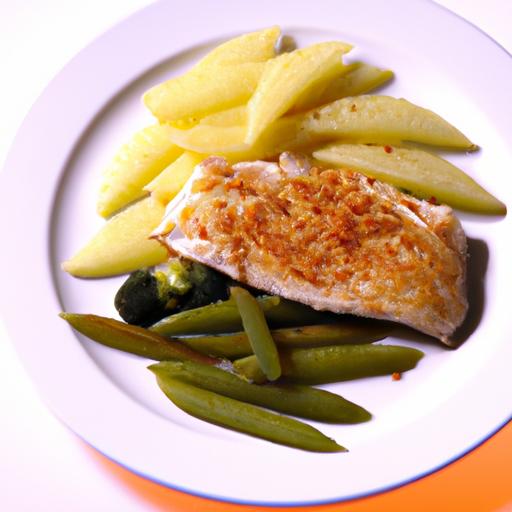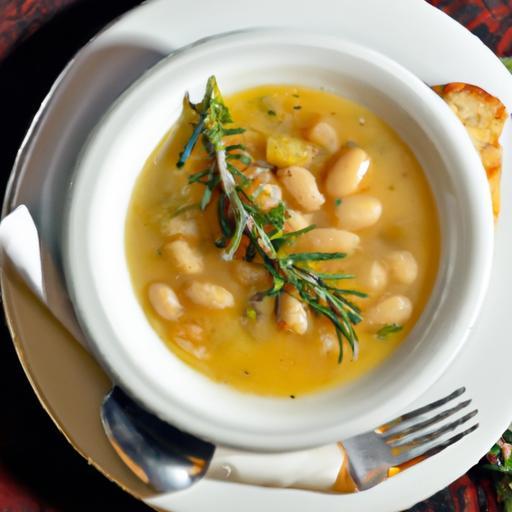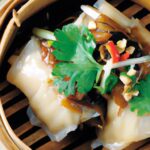There’s a certain magic in a bowl of slow-cooked white bean soup-a humble dish that transforms simple ingredients into a rich tapestry of flavors and textures. But behind this comfort food’s soul-soothing appeal lies a precise dance of science and time. From the gentle coaxing of starches to the melding of aromatic spices, the process of crafting the perfect slow-cooked white bean soup is a fascinating blend of chemistry and patience. In this article, we’ll delve into the science that elevates a pot of beans from ordinary to extraordinary, revealing how temperature, timing, and ingredient harmony come together to create that silky, hearty bowl you crave on a crisp day. Prepare to see your slow cooker not just as a kitchen tool, but as a laboratory where delicious discoveries happen.
Unlocking the subtle magic of slow-cooked white bean soup begins with understanding how the choice of beans and specific soaking methods influence the final texture and flavor. Developing a luscious, creamy soup while coaxing the beans to maintain their integrity calls for precision that only the best bean selection and soaking techniques can deliver. By carefully managing this process, the soup’s flavor develops layers of richness that invite spoon after spoon.
The Science Behind Bean Selection and Soaking Techniques
Starting with quality white beans such as cannellini, navy, or great northern beans ensures a creamy, tender texture. These beans each bring a unique profile: cannellini imparts a rich, buttery mouthfeel, while navy beans add a mild sweetness that pairs beautifully with savory broth. Soaking isn’t just about saving cooking time but about hydrating the beans evenly to avoid splitting and achieve consistent creaminess.
Choose cold water for overnight soaking (8-12 hours) to encourage gentle rehydration without breaking down the bean skins prematurely. For a quicker approach, a hot water soak (boiling water pour-over with a 1-hour rest) softens beans faster but sometimes sacrifices a touch of texture finesse. Always discard the soaking water to reduce compounds that cause digestive discomfort, rinsing the beans well before cooking.
Unlocking the Maillard Reaction Through Controlled Simmering
While the Maillard reaction is famous for dry-heat browning, it plays a subtle yet vital role in slow-cooked soups. The key is controlled, low-heat simmering that encourages slight caramelization of aromatics and broth components without scorching. This reaction builds complex flavors – a savory backbone that elevates the humble white bean soup from simple sustenance to a deep umami experience.
Balancing Aromatics and Broth Composition for Depth and Complexity
The interplay of aromatics such as garlic, onion, celery, and fresh herbs creates an inviting fragrant foundation. Using homemade or high-quality vegetable or chicken broth instead of water enriches the soup, lending savory depth. A pinch of smoked paprika or a subtle splash of dry white wine can introduce intriguing layers. Adding a touch of acidity at the end, like freshly squeezed lemon juice or vinegar, brightens and balances the creamy mouthfeel perfectly.
Optimizing Cooking Time and Temperature for Creamy Consistency
Patience is essential: cooking at a gentle boil just below a simmer (around 185°F/85°C) for 1.5 to 2 hours achieves perfect softness without dissolving the beans into mush. Frequent stirring and careful temperature control prevent scorching at the pot’s base, while slow cooking allows starches to release gradually, thickening the broth naturally. For those with a slow cooker, low heat setting overnight yields unparalleled creaminess with minimal effort.
Prep and Cook Time
- Prep Time: 20 minutes (plus 8-12 hours soaking)
- Cook Time: 1.5 to 2 hours simmering
Yield
Approximately 6 servings
Difficulty Level
Medium – requires gentle temperature control and attentive simmering for best results
Ingredients
- 1 ½ cups dried white beans (cannellini or great northern), soaked overnight and rinsed
- 6 cups homemade chicken or vegetable broth
- 1 medium yellow onion, finely chopped
- 2 stalks celery, diced
- 3 cloves garlic, minced
- 2 tbsp olive oil
- 1 tsp dried thyme or 2 tsp fresh thyme
- 1 bay leaf
- Salt and freshly ground black pepper to taste
- 1 tbsp freshly squeezed lemon juice (optional, for finishing)
- Chopped fresh parsley for garnish
Instructions
- Drain and rinse the soaked white beans. Set aside.
- In a large heavy-bottomed pot, heat olive oil over medium heat. Add onion and celery, sautéing until translucent and slightly golden, about 7 minutes.
- Add minced garlic and thyme, stirring for 1 minute until fragrant.
- Pour in broth and add bay leaf and rinsed beans. Bring to a gentle simmer over medium-low heat.
- Reduce heat to maintain a gentle simmer (small bubbles, not boiling). Cook uncovered for 1.5 to 2 hours, stirring occasionally to prevent sticking.
- Halfway through cooking, taste test the beans. Add salt gradually, as too much early can toughen the skins. Be patient for the ideal tender bite.
- Once beans are tender and broth thickened to a creamy consistency, remove from heat. Discard bay leaf.
- Stir in lemon juice to brighten flavors. Adjust seasoning with salt and pepper as needed.
- Ladle soup into bowls and garnish with fresh parsley before serving.
Chef’s Notes and Tips for Success
- For an even silkier texture, blend one-third of the soup and stir it back in.
- Use a heavy-bottom pot or Dutch oven to prevent burning during long simmering.
- Substitute smoked paprika or a small diced smoked ham hock into the broth for a smoky twist.
- Make-ahead: The soup deepens in flavor overnight and reheats beautifully on low heat.
- Vegetarians can swap chicken broth for mushroom or vegetable broth with an added splash of soy sauce for umami depth.
Serving Suggestions
Serve piping hot with rustic crusty bread to soak up the savory broth. A drizzle of extra-virgin olive oil or a dollop of crème fraîche adds a luxurious finish. Pair with a simple green salad dressed in lemon vinaigrette for a complete meal.
| Nutrient | Per Serving |
|---|---|
| Calories | 320 kcal |
| Protein | 18g |
| Carbohydrates | 45g |
| Fat | 6g |

Explore more on the art of soups in our Ultimate Homemade Broth Guide and deepen your culinary technique. For scientific insights on bean chemistry during cooking, visit ScienceDaily: The Chemistry of Cooking Beans.
Q&A
Q&A: The Science Behind Crafting Perfect Slow-Cooked White Bean Soup
Q1: Why are white beans ideal for slow cooking?
A1: White beans, such as cannellini or navy beans, have a dense structure with a creamy interior that softens beautifully over extended cooking. Their sturdy skins protect the beans during the slow heat process, allowing them to retain shape while the insides melt into a luscious texture. This transformation hinges on the gradual breakdown of starches and pectin, which only slow cooking can achieve gently and thoroughly.
Q2: How does soaking beans before cooking affect the final soup?
A2: Soaking beans rehydrates their cells and initiates the breakdown of complex sugars and proteins, which helps reduce cooking time and prevents digestive discomfort. It also allows beans to cook more evenly, ensuring a consistent creamy texture throughout the soup. Think of soaking as a soft prelude, setting the stage for a harmonious culinary symphony in your pot.
Q3: What role does the slow cooking temperature play in flavor development?
A3: Slow cooking typically uses low, steady temperatures that encourage the Maillard reaction and enzymatic changes without harsh boiling. This gentle heat lets amino acids and sugars mingle, producing deep, savory notes and unlocking subtle sweetness in the beans. It also lets aromatics and herbs infuse thoroughly, marrying their flavors with every tender spoonful.
Q4: Why is layering flavors important in slow-cooked white bean soup?
A4: Layering flavors is a strategic dance of introducing ingredients at different stages to maximize their aromatic and textural contribution. For example, sautéing onions and garlic first unleashes their essential oils, while adding fresh herbs near the end preserves their brightness. This technique transforms each spoonful from simple sustenance into an intricate tapestry of taste.
Q5: How do acidity and seasoning influence the texture of slow-cooked white bean soup?
A5: Acidity from ingredients like lemon juice or vinegar brightens the flavor profile but should be added after the beans have softened. Adding acid too early can toughen bean skins by reinforcing cell walls, impeding the tenderizing process. Similarly, salt enhances flavor but can also firm beans if introduced prematurely. Timing is crucial to achieving a soup that’s both flavorful and velvety.
Q6: What is the scientific explanation for the creamy texture of perfectly slow-cooked white bean soup?
A6: The magic lies in the gelatinization of starches and the disintegration of cell walls within the beans. Prolonged, moist heat causes starch granules to swell and absorb liquid, thickening the broth. Simultaneously, cell wall breakdown releases pectin and proteins, creating a silky mouthfeel. The longer and gentler the cook, the creamier and richer the soup becomes.
Q7: Can the choice of cooking vessel affect the outcome of white bean soup?
A7: Absolutely. Heavy-bottomed pots like Dutch ovens distribute heat evenly and retain it well, preventing hotspots that could cause uneven cooking or scorching. Ceramic or enameled cast iron vessels also maintain moisture and promote steady simmering, which is essential for uniform bean softening and flavor melding.
Q8: How does slow cooking impact the nutritional value of white bean soup?
A8: Slow cooking preserves most nutrients by using moderate heat and extended cooking times that avoid nutrient burnout from rapid boiling. While water-soluble vitamins may leach slightly into the broth, drinking the soup whole captures these nutrients. Additionally, prolonged cooking improves digestibility and bioavailability of proteins and minerals in white beans.
Crafting the perfect slow-cooked white bean soup is a delicate science, where patience and understanding the chemistry of beans transforms humble ingredients into a bowl of satisfying, soulful nourishment.
The Conclusion
As the last spoonful of slow-cooked white bean soup warms your senses, it’s clear that this humble dish is much more than comfort food-it’s a symphony of science and tradition. From the meticulous soaking and gentle simmering that unlock the beans’ creamy essence, to the careful layering of flavors that dances on your palate, every step is a testament to the alchemy of cooking. Understanding the science behind this timeless recipe not only elevates your culinary skills but also deepens your appreciation for the magic that unfolds in a pot of patiently crafted soup. So next time you stir that bubbling cauldron, remember: you’re not just making a meal-you’re crafting a masterpiece, one molecule at a time.


